-
 What is Glue?
What is Glue? - Definition from the Merriam-Webster Dictionary:
- 1 a: any of various strong adhesive substances ; especially : a hard protein chiefly gelatinous substance that absorbs water to form a viscous solution with strong adhesive properties and that is obtained by cooking down collagenous materials (as hides or bones) b: a solution of glue used for sticking things together
- Hm – not what I am looking for, if you need it, you can buy it here – end of story.
- 2 something that binds together <enough social glue…to satisfy the human desire for community — E. D. Hirsch, Jr.>
-
Social Glue … now we’re getting closer. So again, what is Glue? There are several companies in the software business with
goo-yglue-y products:Glue is Companies and Products
AdaptiveBlue has a browser extension called Glue. (Blue Glue?
 ) VC and Blogger Fred Wilson aptly calls it A Social Net That Lives In Your Browser.
) VC and Blogger Fred Wilson aptly calls it A Social Net That Lives In Your Browser. Then there is Yahoo Glue. And of course there are a bunch of companies that don’t call themselves or their products Glue – they just do it.
Gnip’s mission is elegantly “Making data portability suck less”. Here’s an easy (?) chart explaining what they do:

Boomi is another Glue company, providing integration Platform-as-a-Service (iPaaS – ah, starting 5-letter acronyms
 ). Read their thought-provoking post on Why APIs Don’t Solve the SaaS Integration Challenge.
). Read their thought-provoking post on Why APIs Don’t Solve the SaaS Integration Challenge. MindTouch started their life as a wiki company, and grew into “an open source enterprise collaboration and community platform that enables users to connect and remix enterprise systems, social tools and web services.”. Ouch, that sounds so official – here’s another version from the Chief Conductor who just returned from a major Product Launch:
We do orchestration for a myriad of systems, databases and any web service, all with a easy to use wiki-like interface.
Let’s not forget about Mashery, plumbers of the Web, or more elegantly, a “leading provider of API management services enabling companies to easily leverage web services as a distribution channel.”
The list can go on and on, and even in the current downturn we will see more Glue companies. In fact Glue has become investment theme for some really smart VCs:
Glue is our term for the web infrastructure layer that facilitates the connections between web services and content companies
Glue is a Concept – actually, several concepts
- Enterprise Glue: A "web oriented architecture" and beyond SOA
- Data Glue: Mash-ups, mash-ups and more mash-ups
- Social Network Glue: The movement toward cross-network interoperability and data sharing
- Interface Glue: Cross-platform, cross-browser technologies like Silverlight and Adobe Air
- Messaging Glue: Tools that are evolving for meta-messaging
- Identity Glue: Reputation, user-centric identity and web sso
- OS Glue: Cross-operating system runtimes
- Marketing Glue: The abstraction of the management of ad platforms into a common interface
- Infrastructure Glue: Cloud and Utility computing that binds back-end services
Oh, boy. This is big, way over my head. I better leave this discussion to smarter people who actually understand the technology behind all this.
 But I’ll share a secret: they will all come together in Denver, on May 12-13 of this year. Will you be there?
But I’ll share a secret: they will all come together in Denver, on May 12-13 of this year. Will you be there?Glue is a Great Conference – Get Sticky Now
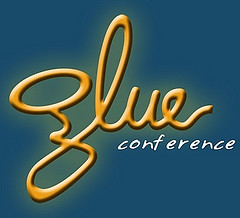 I’ve discussed earlier how Defrag was the best Conference I attended for quite a while. The conference Theme, sessions, very active participants, the venue, the infrastructure (working wi-fi, no small feat!) – you name it, it all came together perfectly. So when Defrag’s organizer, Eric Norlin sets out to launch another conference discussing all of the above and more, it’s bound to be a success. Here’s Eric’s summary:
I’ve discussed earlier how Defrag was the best Conference I attended for quite a while. The conference Theme, sessions, very active participants, the venue, the infrastructure (working wi-fi, no small feat!) – you name it, it all came together perfectly. So when Defrag’s organizer, Eric Norlin sets out to launch another conference discussing all of the above and more, it’s bound to be a success. Here’s Eric’s summary:Glue is the only conference devoted solely to solving the web application integration problem-set. People that should attend Glue include the architects, developers, administrators and integrators that have moved past the initial step of seeing the web as a platform, and are facing the real-world challenges of what "stove-piped" web applications mean for their overall strategy. Glue is about all of bits and pieces, APIs and meta-data, standards and connectors that will help us to glue together the varying applications of the new platform.
The Agenda is shaping up, Sponsors are in, and reservations are coming through nicely, recession or not. Like I’ve said, Some Conferences Are Worth Attending Even in Bad Times.

Of course getting a bargain helps in bad times: where else do you get an intense top-notch conference for $395? That is if you catch early bird reservation, so hurry, get sticky now.
By the way, participation does not start in May – you can share ideas right now, I’ll help with resources. CloudAve, my main blogging gig is pleased to be the Media Sponsor for Glue, and you will see a stream of related posts over there as we approach the Conference dates (this may be the right time to grab the CloudAve Feed). We invite everyone interested to participate: please submit your post, we’ll be happy to publish it. And if you prefer to post in your own blog, wiki, Twitter, FriendFeed, Facebook…whatever – just make sure to use the tag gluecon (since glue might find – you know, this). We’ll find your post and pull it under the Glue Tab, which will soon turn into a resource list of all-things-glue.
On a personal level I am stoked to be able to serve on the Glue Conference‘s Advisory Board along with great thinkers like Amy Wohl, Phil Wainewright, Chris Shipley, Mike West, and Albert Wenger. I’m really excited about this Conference, and am looking forward to meeting many of you.
What are you waiting for? Get Sticky Now!

(Cross-posted from CloudAve)

Is the USA Really the Broadband Leader?
The US is not exactly the leader when it comes to Broadband or even Mobility – in fact we’re way behind several Asian and European countries.
But is that really true? Professor Leonard Waverman of the London Business School disagrees. He published a study on the World’s Connectivity Scorecard. His key thesis is that penetration and connection speed is not enough to measure true connectedness: we have to consider to what extent the Consumer, Businesss and Government sectors put broadband to productive use.
The compound index reveals a few surprises: the USA is actually #1, closely followed by Sweden and Denmark, and in fourth position (surprise!?!) is Malaysia, leaving countries like Japan, Korea, Norway in the dust.
I am not entirely convinced about the US position, especially if we take a look at the Consumer vs Business segmentation … and don’t get me started on Government.
Update: Vinnie Mirchandani points out the serious flaws in the Study Methodology.

Resistance is Futile: We Will Be Assimilated – by Google.
Two seemingly unrelated items:
Today Hitwise reported on how Google Maps is catching up on Mapquest, which once was the king of online mapping.
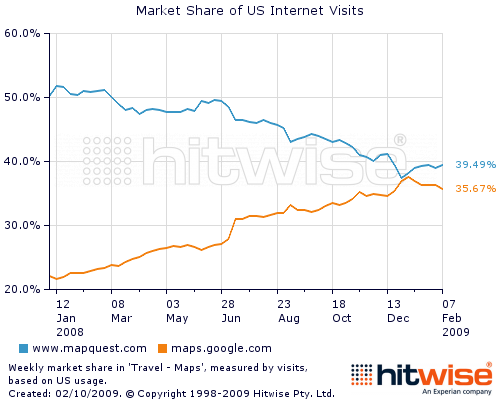
Perhaps more important than just the numbers is the source of traffic: 61% of Google Maps traffic comes from links placed in organic Google Search results. Contrast that to Mapquest, where 8 out of 10 hits come from searches on the Mapquest brand itself. Translation: Mapquest is only used by its already dwindling user base, while Google Maps gains steadily, since Google owns Search. The writing is clearly on the wall.
The second story: Google Gmail Within Striking Distance Of Hotmail – reported Information Week a few days ago. Wait, wasn’t Gmail supposed to be email for the geeks only, lagging behind the masses of Yahoo and Hotmail users?
Between September 2007 and September 2008, Gmail’s visitor total grew 39%, from 18.8 million to 26 million, ComScore figures indicate. Windows Live Hotmail during this period saw its visitor share decline 4%, from 46.2 million to 44.6 million.
If Google’s Gmail growth rate rises to, say, 46% over 2009, it could reach approximately 43 million unique U.S. visitors by the end of the year. And if Windows Live Hotmail continues to bleed visitors at a rate of, say, 3%, it will finish the year with around 42 million unique visitors per month.
So Gmail may overtake Hotmail by the end of this year, and if the trend continues, it might overtake Yahoo by the end of 2011, concludes Information Week. Note, these are site visits, not account numbers, but account numbers include all the throw-away, long forgotten dormant accounts that both Yahoo and Hotmail has in abundance. All these email systems being web-based, visitor stats are a better representation of actual usage.
The third story (yes, I promised two, but can’t stop now): The Google Power Meter., currently being tested by Google employees. These are smart devices you plug in all around the house, they will report back to the mothership and you get a nice dashboard aimed at helping you making the right energy choices.

I would certainly like to know just how “smart” they can be – any chance of bi-directional communication? I can’t help but remember the mail campaign from PG&E, my utility company. They are handing out $25 to anyone who allows them to install a smart thermostat free of charge. The catch? At times when consumption reaches peak levels, the utility company can remotely throttle back your air conditioner. So now you see why I’m hesitant about these Google electricity meters. Could they be switched from passive reporting to regulating one day?
The fourth story (gee, I really have to stop soon): An opinion piece on Bloomberg discusses how the health provisions slipped into the stimulus bill will effect every one of us in the US:
Your medical treatments will be tracked electronically by a federal system. Having electronic medical records at your fingertips, easily transferred to a hospital, is beneficial. It will help avoid duplicate tests and errors. But the bill goes further. One new bureaucracy, the National Coordinator of Health Information Technology, will monitor treatments to make sure your doctor is doing what the federal government deems appropriate and cost effective. The goal is to reduce costs and “guide” your doctor’s decisions (442, 446).
Ouch. I’m all for electronic medical records, but I don’t want them to be turned into a Big Brother function. And I don’t want a computer program to decide on my medical treatment. But I’ve just complained about the Sorry State of Health 2.0: neither Google Health nor Microsoft HealthVault are up to the job yet. I want them to get there, and I trust they will (at least one of them). I don’t want them to run my health care, just help me and my providers manage it – but fear of potential misuse won’t stop my desire for progrees.
Do you see the trend here? Google is unstoppable. They want to manage all data, but our life is increasingly all about data and what we do with it. The former Borg in Redmond is now a toothless veteran, slowly dwindling away – Google is the New Borg. Resistance is futile. We’re being assimilated. And we like it. Enjoy the video: (better quality if you click through)
Related posts:
(This post originally appeared @ CloudAve. To stay abreast of Clod Computing, SaaS news and analysis, grab the CloudAve feed here.)

Comcast Digital Enhancement Off to an Analogue Start
Comcast is “enhancing” their network, converting all but the Limited Basic channels to digital only. This is NOT the government mandated digital transition, which would require no additional set-top boxes for cable-connected TV’s. This is Comcast’s on upgrade, and one that requires a digital box, if you want to continue to receive channels above 35, including CNN, Fox, MSNBC, ESPN, USA, MTV, USA, LIFE – just to name a few.
They are sending out flyers now (so don’t throw it in junk mail), and you can sign up for two free boxes at www.comcast/digitalnow, or call a customer service number. I have both digital box connected and standalone TV’s in the house, so decided to act now, before I forget. You can guess which option I took: wait on the phone or get done in a few clicks…
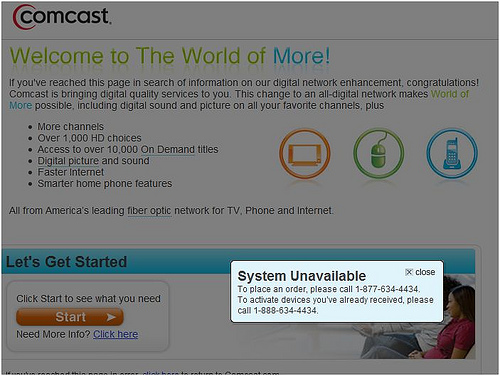
Oops! System Unavailable: call a number. In fact call it twice, once to order, then again to activate. A rather analogue way to start the digital transition. Comcast: FAIL.
Update (2/8/09): Tweeting it up with @comcastcares. Will see if this helps …
Update (2/9/09): The error message is now changed from “System Unavailable” to “Please Call Us”. This might give the impression there is something with your account, rather than a system error. I guess that’s a way of “fixing” the problem. 🙁
Please Call Us
We apologize, but we are unable to process your request online. To order digital devices, please call 1-877-634-4434. To activate digital devices you’ve already received, please call 1-888-634-4434
Update (2/26/09): 3 weeks later the error is still not fixed. The Web site Comcast’s mass mail points to is dead. I guess not even @comcastcares has magic powers…

Google Health & Microsoft HealthVault: the Sorry State of Health 2.0
Today’s joint IBM – Google announcement about enabling personal health monitoring devices to send data directly to Google Health gave me the grand opportunity for a (not-so) quick rant that’s been boiling in me for a while.
Ever since I started actively managing my parents’ health care I’ve been a heavy user of electronic health records and communication systems, and I am immensely frustrated. Frustrated at the paper-based world we’re facing in the 21st century, but also at the current attempts to change all that. Grand ideas, alliances, announcements, but they all feel like IT-talk, losing sight of the very people these systems supposed to serve: patients. That’s you and me and our relatives who have health issues.

Netbooks as Fashion Items
 Dennis calls the Netbook craze a fashion game. He just doesn’t see the value – I strongly disagree. But let’s just stay with the fashion line for a minute. Dennis’s normally technophobic wife asked him:
Dennis calls the Netbook craze a fashion game. He just doesn’t see the value – I strongly disagree. But let’s just stay with the fashion line for a minute. Dennis’s normally technophobic wife asked him:
“Have you heard about those laptops you can put in your handbag?”
Hm… it’s February 2nd – do I need to remind my male readers what comes in barely two weeks?
Here’s the perfect Valentine Day gift: a pink Netbook. Or Pinkbook. Or Pursebook. 
Udate: on second thought, you can get a lot fancier:
Update: Cote points out a related ad. Yes, there is a Netbook on that photo.. somewhere. 

InfoWorld’s 2009 Technology of the Year Awards
InfoWorld announced the winners of the 2009 Technology of the Year Awards in Applications, Middleware, and Data Management:
The Awards are presented in a slideshow format, and InfoWorld made it almost unreadable: there is an ad in between every single page, you either 20 second to flip a page, or have to click “skip” every single time, then click one more time to close another page that hides the slide. Frankly, I think they went way overboard with this.
That said, I did the work for you, here are the winners:
- Mozilla Firefox
- Zoho Writer, Sheet, Show
- Day Communique WCM
- Telligent Community Server 2008
- Oracle Database 11g
- Talend Open Studio
- Denodo Platform
Congratulations to the winners!
(Cross-posted from CloudAve)

Hulu Fails on Inauguration Day
O-Day was supposed to be the first US Presidential Inauguration largely available online. I thought it was a good idea to provide the embedded video here, courtesy of Hulu. It worked well for hours .. during the countdown.
Then it promptly died as soon as the actual broadcast started. It appears Hulu killed the embed feed, while the video on hulu.com itself is still working well.
Hulu = Fail on O-Day. Way to welcome the first tech-savvy US President.

CrunchPad: a Keyboard-less Netbook
 I admit I was skeptical when Mike Arrington first announced he wanted to build a lightweight Web Tablet. Skeptical partly because I had just witnessed Ismael Ghalimi of the Office 2.0 fame feverishly work on the Redux Model 1. I had been doubtful about his effort, too, but his energy level was just radiating, he actually convinced me, I started to believe… But in the end, all the effort (and quite some money Ismael spent along the way) came down to nothing, he nuked the device, and the Office 2.0 Conference gadget became an HP 2133 Mini-Note PC.
I admit I was skeptical when Mike Arrington first announced he wanted to build a lightweight Web Tablet. Skeptical partly because I had just witnessed Ismael Ghalimi of the Office 2.0 fame feverishly work on the Redux Model 1. I had been doubtful about his effort, too, but his energy level was just radiating, he actually convinced me, I started to believe… But in the end, all the effort (and quite some money Ismael spent along the way) came down to nothing, he nuked the device, and the Office 2.0 Conference gadget became an HP 2133 Mini-Note PC.
Fast-forward half a year, and TecCrunch is showing off a prototype. Granted, it’s not as cool-looking as the initial sketch above, but this one is working.
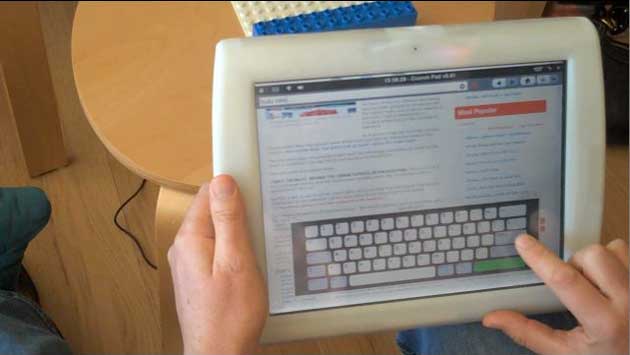

Your Digital Data My Not Be Accessible Soon
So you’re doing the right thing, backing up everything on CDs or DVDs. Too bad they may not be readable in a few years… and even if they are, you still have to worry about data formats.
Data sitting on your hard disk may not be much better: in fact files you created with the very apps you’ve just upgraded to the most recent version my no longer be readable by the current version anymore.
Read the details here…
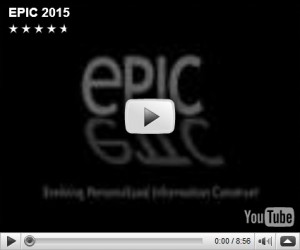
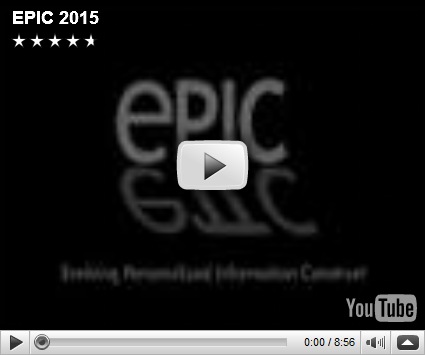
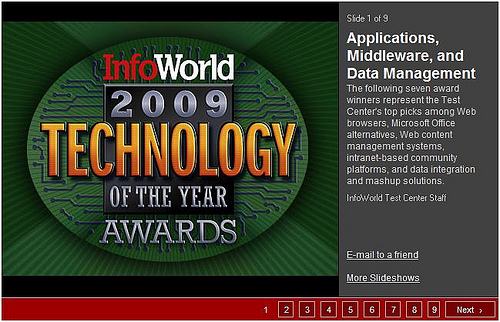

Recent Comments